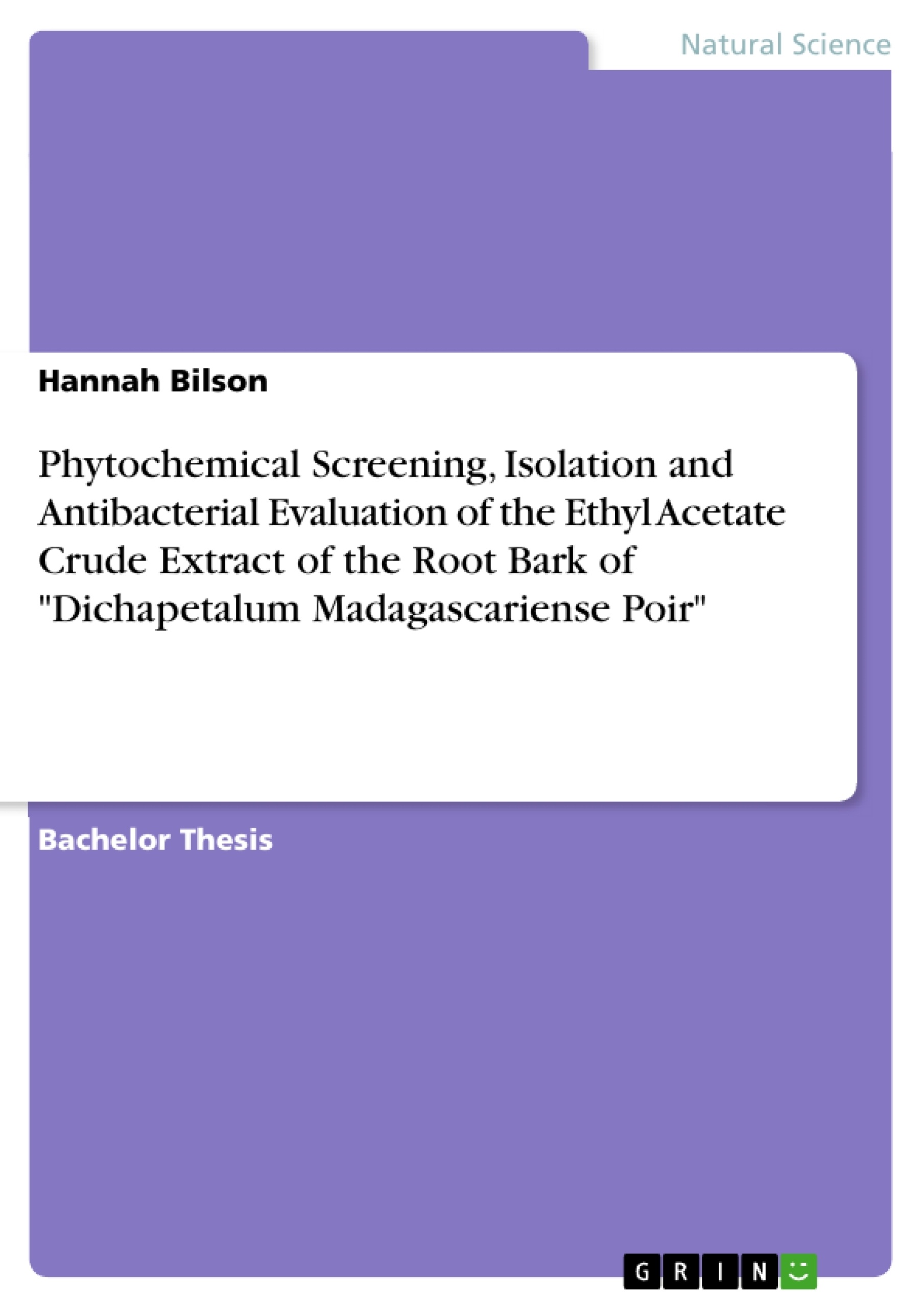Dichapetalum madagascariense. Poir belongs to the family Dichapetalacease. In this present study, the antibacterial activity of the ethyl acetate extract of the root was investigated by soxhlet extraction process. Agar well diffusion method was employed to evaluate antibacterial activity of extracts against Gram positive and Gram negative bacteria. The root extract was effective in causing inhibition of some of the test bacteria. The highest and least inhibitory activities were observed against Staphylococcus aureus and Pseudomonas aeruginosa respectively, while Escherichia coli was resistant. The extract was more effective in inhibiting the growth of Staphylococcus aureus as compared to the standard antibiotic used as a positive control. The solvent for extraction, ethyl acetate, did not affect the biological activity of the crude extract.
TABLE OF CONTENT
DEDICATION
ACKNOWLEDGEMENT
ABSTRACT
LIST OF TABLES
LIST OF FIGURES
CHAPTER ONE INTRODUCTION
1.1 Background
1.2 The Family Dichapetalaceae
1.3 Plant Description
1.4 Classification of Plant
1.5 Plant Distribution
1.6 Ethnobotanical Use of Dichapetalum Madagascariense
1.7 Local Names of Dichapetalum Madagascariense:
1.8 Search for New Antimicrobial Agents
1.9 Some Bacterial Infections
1.9.1 Staphyloccocus Aureus
1.9.2 Pseudomonas Aeruginosa
1.9.3 Klebsiella Pneumoniae
1.9.4 Salmonella Typhi
1.10 Statement of Problem
1.11 Justification of Study
1.12 Aim
1.13 Specific Objectives
CHAPTER TWO LITERATURE REVIEW
2.1 Review on Dichapetalum madagacariense
2.2 The Dichapetalin
2.3 Organic Solvents
2.4 Solvents for Extracting Bioactive Compounds
2.5 Phytochemicals
2.5.1 Saponins
2.5.2 Flavonoids
2.5.3 Tannins
2.6 Examples of Phytochemicals Found in Foods and Their Benefits
2.7 Antibacterial Determination
2.7.1 Susceptibility Test
2.8 Agar and Broth Dilution
2.8.1 Well Diffusion Method and Kirby Bauer Disk Diffusion
2.8.2 Gradient Diffusion – The E Test (Epsilometer Test)
CHAPTER THREE EXPERIMENTAL PROCEDURE
3.1 METHODS
3.2 Chemicals
3.3 Instrument and Equipment/Glassware
3.4 Sample Collection and Treatment
3.5 Hot Extraction Procedure
3.6 Phytochemical Screening Analysis
3.6.1 Test for Saponins
3.6.2 Test for Phenolic Compounds
3.6.3 Test for Polyuronides
3.6.4 Test for Tannins
3.6.5 Test for Flavonoids
3.6.6 Test for Terpenoids
3.6.7 Test for Phytosterols
3.7 Thin Layer Chromatography
3.8 Column Chromatography
3.9 Antibacterial Susceptibility Test
3.9.1 Preparation of The 0.5 Mcfarland Standard
3.9.2 Inoculation
3.9.3 Media Preparation
3.9.4 Antibacterial Susceptibility Testing On Crude Extract
CHAPTER FOUR RESULTS
4.1 Phytochemical Test
4.2 Discussion
CHAPTER FIVE CONCLUSION AND RECOMMENDATION
5.1 Conclusion
5.2 Recommendations
REFERENCES
- Quote paper
- Hannah Bilson (Author), 2019, Phytochemical Screening, Isolation and Antibacterial Evaluation of the Ethyl Acetate Crude Extract of the Root Bark of "Dichapetalum Madagascariense Poir", Munich, GRIN Verlag, https://www.grin.com/document/1324425
-

-

-

-
Upload your own papers! Earn money and win an iPhone X. -

-
Upload your own papers! Earn money and win an iPhone X. -

-
Upload your own papers! Earn money and win an iPhone X. -

-
Upload your own papers! Earn money and win an iPhone X. -

-
Upload your own papers! Earn money and win an iPhone X. -

-
Upload your own papers! Earn money and win an iPhone X. -

-
Upload your own papers! Earn money and win an iPhone X. -

-
Upload your own papers! Earn money and win an iPhone X. -

-
Upload your own papers! Earn money and win an iPhone X. -

-
Upload your own papers! Earn money and win an iPhone X. -

-
Upload your own papers! Earn money and win an iPhone X.

